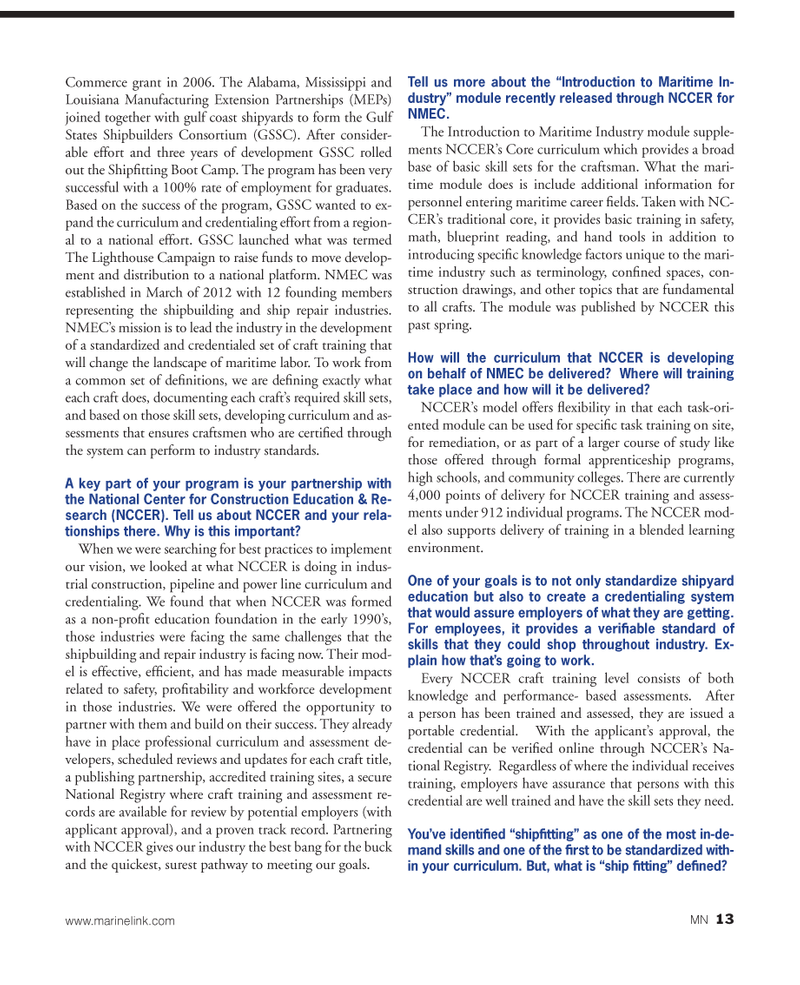
Page 13: of Marine News Magazine (July 2013)
Propulsion Technology
Read this page in Pdf, Flash or Html5 edition of July 2013 Marine News Magazine
Commerce grant in 2006. The Alabama, Mississippi and Louisiana Manufacturing Extension Partnerships (MEPs) joined together with gulf coast shipyards to form the Gulf States Shipbuilders Consortium (GSSC). After consider- able effort and three years of development GSSC rolled out the Ship? tting Boot Camp. The program has been very successful with a 100% rate of employment for graduates. Based on the success of the program, GSSC wanted to ex- pand the curriculum and credentialing effort from a region- al to a national effort. GSSC launched what was termed The Lighthouse Campaign to raise funds to move develop- ment and distribution to a national platform. NMEC was established in March of 2012 with 12 founding members representing the shipbuilding and ship repair industries. NMECs mission is to lead the industry in the development of a standardized and credentialed set of craft training that will change the landscape of maritime labor. To work from a common set of de? nitions, we are de? ning exactly what each craft does, documenting each crafts required skill sets, and based on those skill sets, developing curriculum and as- sessments that ensures craftsmen who are certi? ed through the system can perform to industry standards. A key part of your program is your partnership with the National Center for Construction Education & Re-search (NCCER). Tell us about NCCER and your rela- tionships there. Why is this important? When we were searching for best practices to implement our vision, we looked at what NCCER is doing in indus- trial construction, pipeline and power line curriculum and credentialing. We found that when NCCER was formed as a non-pro? t education foundation in the early 1990s, those industries were facing the same challenges that the shipbuilding and repair industry is facing now. Their mod- el is effective, ef? cient, and has made measurable impacts related to safety, pro? tability and workforce development in those industries. We were offered the opportunity to partner with them and build on their success. They already have in place professional curriculum and assessment de- velopers, scheduled reviews and updates for each craft title, a publishing partnership, accredited training sites, a secure National Registry where craft training and assessment re- cords are available for review by potential employers (with applicant approval), and a proven track record. Partnering with NCCER gives our industry the best bang for the buck and the quickest, surest pathway to meeting our goals. Tell us more about the Introduction to Maritime In- dustry? module recently released through NCCER for NMEC. The Introduction to Maritime Industry module supple- ments NCCERs Core curriculum which provides a broad base of basic skill sets for the craftsman. What the mari- time module does is include additional information for personnel entering maritime career ? elds. Taken with NC- CERs traditional core, it provides basic training in safety, math, blueprint reading, and hand tools in addition to introducing speci? c knowledge factors unique to the mari- time industry such as terminology, con? ned spaces, con- struction drawings, and other topics that are fundamental to all crafts. The module was published by NCCER this past spring.How will the curriculum that NCCER is developing on behalf of NMEC be delivered? Where will training take place and how will it be delivered? NCCERs model offers ? exibility in that each task-ori- ented module can be used for speci? c task training on site, for remediation, or as part of a larger course of study like those offered through formal apprenticeship programs, high schools, and community colleges. There are currently 4,000 points of delivery for NCCER training and assess- ments under 912 individual programs. The NCCER mod- el also supports delivery of training in a blended learning environment. One of your goals is to not only standardize shipyard education but also to create a credentialing system that would assure employers of what they are getting. For employees, it provides a veri? able standard of skills that they could shop throughout industry. Ex- plain how thats going to work. Every NCCER craft training level consists of both knowledge and performance- based assessments. After a person has been trained and assessed, they are issued a portable credential. With the applicants approval, the credential can be veri? ed online through NCCERs Na- tional Registry. Regardless of where the individual receives training, employers have assurance that persons with this credential are well trained and have the skill sets they need. Youve identi? ed ship? tting? as one of the most in-de- mand skills and one of the ? rst to be standardized with- in your curriculum. But, what is ship ? tting? de? ned? MN 13www.marinelink.com MN July2013 Layout 1-17.indd 136/28/2013 9:51:03 AM

 12
12

 14
14
